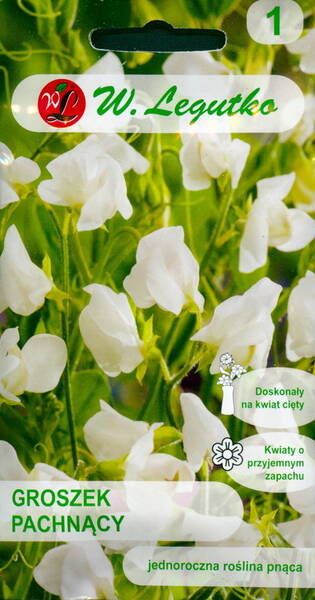First class!
HA - Hardy annual. Height 2,0 m.
CULTURE: Sow January-March under glass in gentle heat or in April-May outdoors for flowers June-September. Can also be sown in September-October in a cold frame or greenhouse to overwinter in frames to produce the earliest blooms.
HINTS: Ideal climber. Scented. Attractive to butterflies. Ideal as cut flowers. Pick regularly to encourage more flowers.
Flowering Time: June-September.

Blooms from July to September. The flowers are large, collected in graceful brushes of 5-8 flowers. The flowers have a pleasant delicate aroma.
Light-loving, moisture-loving and cold-resistant, prefers fertile loamy and sandy soils. Grow seedlings and seedless way. In open ground, sowing is carried out in the first decade of May. For seedlings, seeds are sown in late March-early April in pots. Seedlings are planted in mid-May at a distance of 25-30 cm. It is advisable to germinate the seeds before sowing.
Used in landscaping, in addition, cut flowers retain their freshness well in water and are used in bouquets.
* "Fragrant and very attractive" - this is how the botanical name of the plant is translated from Greek.
China fragrant is an annual plant with climbing stems, up to 200 cm high. Over the summer, the plant produces such a number of inflorescences as no other and therefore is valued as a cut crop. It is necessary to cut off the inflorescences of peas, as this stimulates the formation of new ones in even greater numbers.
Sweet peas bloom from June until the first frost. Peas are very photophilous and cold-resistant, tolerating short-term frosts down to -5°C. It develops more readily in sunny places protected from the wind, in light fertile soil without fresh organic fertilizers.
Do not overfeed peas with nitrogen fertilizers, as their excess stimulates intensive growth of green mass at the expense of flowering. Water the plants rarely, but plentifully. With a lack of moisture, the buds fall, and the flowers become smaller and quickly wither. The most optimal time for watering is 1 time in 10 days. You need to direct the sweet pea stems to the supports as soon as possible, otherwise, you risk breaking the fragile stems. The shape of the support can be the most diverse, but most often peas are grown on trellises or in pyramids.
.jpg)
Sweet pea, sweetpea.
* In Estonia, sweet pea seeds ripen in early September. Seed formation slows down flowering, so it is better to leave 1-2 plants specifically for breeding, without cutting off their flower stalks.
The seeds are quite large, with a hard shell. Before planting, soak them in warm (+60°C) water and germinate in a humid environment. You can specially carefully cut the shell for quick germination.
Since flowering occurs 2-3 months after germination, plant the seeds in late March - early April in peat-humus pots with a nutritious soil mixture, one or two or three seeds per hole. For better branching, pinch young plants above the third leaf. The seedling growing period lasts about 40 days.
Peas can be planted in open ground as early as the first ten days of May with a distance of 20-25 cm between plants. The root system of sweet peas is sensitive to damage, and growth begins only after two weeks. Therefore, it is better to plant the plants with a lump of earth.
Sprouted seeds can be planted in the ground in early May, but flowering in this case will occur two weeks later. To obtain the most spectacular inflorescences, leave 1-2 of the strongest stems on the plant and remove the rest.
Regularly pinch off the side shoots and part of the tendrils so that the plant spends nutrients on the formation of buds.
Sweet peas are fed twice: the first feeding is carried out at the beginning of stem growth with a complex organo-mineral fertilizer, the second - when buds appear, with a phosphorus-potassium fertilizer.












